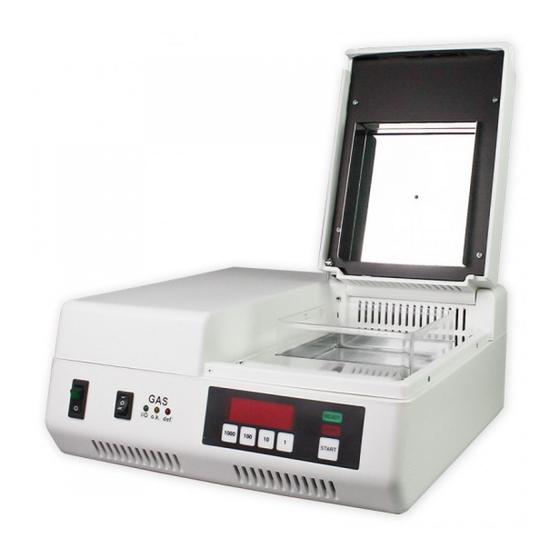Advertisement
Quick Links
Index
1)
Device description
2)
Initial operation of device
3)
Important notes
4)
Holding trays
5)
Operation
6)
Maintenance, cleaning, repair
7)
Exchanging the flash-module
8)
Transport, storing, disposal
9)
Protective gas option
10) Technical data
________________________________________________________________________________________________________________
Otoflash G171
UV-flash curing device
Instruction Manual
page 1 of 11
Advertisement

Subscribe to Our Youtube Channel
Summary of Contents for NK-Optik Otoflash G171
- Page 1 Otoflash G171 UV-flash curing device Instruction Manual Index Device description Initial operation of device Important notes Holding trays Operation Maintenance, cleaning, repair Exchanging the flash-module Transport, storing, disposal Protective gas option 10) Technical data ________________________________________________________________________________________________________________ page 1 of 11...
-
Page 2: Device Description
Device description The Otoflash G171 device may be used for the curing of light-curable resins light-induced polymerization. There are 2 bottom-mounted flash-lamps, operating at a frequency of 10 flashes per second. Compared to polymerisation through continuous exposure, the curing by means of flashes of light has the following advantages: 1.) At the same radiation dosage, the light intensity is between 1,000 to 10,000 times higher... - Page 3 Initial operation of device Before initial operation, adjust the device to the correct voltage using the voltage selector switch on the back of device (12). When moving the Otoflash device from colder to warmer ambient temperature (e.g. transport during winter), allow the device to acclimatize for a minimum of 2 hours before switching it on (otherwise risk of flash-overs inside the device).
-
Page 4: Important Notes
The holding trays are designed to be used with nitrogen (N ). You must contact the device manufacturer (NK-Optik GmbH) if you intend to use a different inert protective gas (e.g. argon or carbon dioxide) to identify appropriate alternative trays. -
Page 5: Operation
Operation Setting the timer The device is switched on with the main switch (1). The green light indicator labelled “Ready” (7) will light up and 4-digit figure will appear on the display (4). This figure indicates the number of flashes. The number of flashes can be programmed any number between 0 and 9999 by pressing the buttons 1000, 100, 10 and 1. -
Page 6: Service & Maintenance
The flash-module must only be blown-out by means of compressed air using slight over- pressure. Never clean the flash-bulbs with cleaning agents or cloths! Only the reflector may be cleaned with a lint-free cloth. - Service/Maintenance Servicing may only be carried out by NK-Optik GmbH. ________________________________________________________________________________________________________________ page 6 of 11... - Page 7 Exchanging the flash-module Warning: Before carrying out any service or maintenance work, the device should be disconnected from the power supply (otherwise danger due to electric shock). The flash-bulbs can only be replaced by replacing the entire flash-module. - If needed, allow old flash-bulbs to cool off by running the device in stand-by mode for approximately 1 minute.
- Page 8 Transport, storing, disposal - Transport For transport and storing of up to 6 months, the following conditions apply: Temperature: 0°C - 70°C Relative humidity: 10% - 80% Afterwards, values from operation conditions apply: Temperature: + 10°C - 40°C Relative humidity: 20% - 80% Storing is only permissible in closed rooms.
- Page 9 7 Transport, Storing, Disposal 9) Protective gas option When using the protective gas option, oxygen will be displaced from the polymerisation chamber. This prevents oxygen inhibition allowing workpieces to cure without an inhibition or adhesive residue layer at the surface (section 1, paragraph 3). The following additional components are included in models with the Protective gas option: On the back of the device: a quick coupling adapter (with a nominal diameter of 7.2 mm) for connection to a gas cylinder.
- Page 10 , with a quality level of 2.6 (i.e., 99.6% purity) or higher (e.g. 3.0 at 99.9% or 5.0 at 99.999% purity) as protective gas for this device. Contact the device manufacturer (NK-Optik) before you intend to use any alternative inert gases for the protective gas function.
- Page 11 10) Technical data Otoflash G171 Voltage: 100, 115, 230 Volts AC Frequency: 50/60 Hz Power consumption: ca. 250 Watts Dissipated power: ca. 200 Watts Flash frequency: 10 flashes per second Life duration of flash bulbs approx. 250 hours Digital timer: programmable from 1 to 9999 flashes Size of polymerization chamber: ca.


Need help?
Do you have a question about the Otoflash G171 and is the answer not in the manual?
Questions and answers